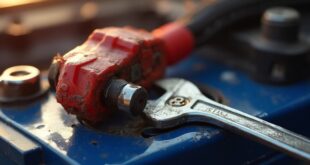To disconnect a car battery safely, start by wearing safety goggles and gloves. Work in a dry, well-ventilated area, and avoid metal contact with terminals. Turn off the ignition, then disconnect the negative terminal first, followed by the positive. Secure the terminals away from the battery. When removing the battery, lift it straight up to avoid spills, and verify it's secured in its new location. Want to know more about proper installation and maintenance?
Safety Precautions Before Disconnecting the Battery
Before you disconnect the battery, it's crucial to prioritize safety to prevent accidents.
Start by wearing safety goggles and gloves to shield yourself from acid and sparks. Avoid jewelry, which could accidentally touch battery terminals.
Always work outdoors to minimize exposure to harmful gases, and verify your area is dry and well-ventilated. Keep flammable materials away from the battery, and remember that disconnecting it might reset your electronic settings.
By taking these precautions, you'll create a safer environment for yourself while handling the battery, reducing the risk of shock or injury considerably.
Safety first establishes a smoother process.
Essential Tools and Equipment Needed
Having the right tools and equipment is essential for safely disconnecting a car battery. You'll need a few key items to guarantee the process goes smoothly. Here's a quick list of what to gather:
| Tool/Equipment | Purpose |
|---|---|
| Adjustable Wrench | To loosen terminal bolts |
| Wire Brush | For cleaning terminals |
| Safety Goggles | To protect your eyes |
| Gloves | To prevent acid exposure |
| Multimeter (optional) | To check battery voltage |
With these tools, you'll be prepared to disconnect your car battery safely and efficiently.
Step-by-Step Guide to Disconnecting a Car Battery
Disconnecting a car battery safely involves a series of straightforward steps that anyone can follow. Start by ensuring the ignition is off and the hood is open.
Then, locate the battery and proceed with the following:
- Disconnect the negative terminal first to minimize sparks.
- Secure the negative terminal away from the battery.
- Disconnect the positive terminal, avoiding any metal contact.
- Double-check that both terminals are completely removed.
Once you've completed these steps, you can move on to battery removal or maintenance.
Always remember to wear safety gear throughout the process to protect yourself.
Removing the Battery From the Vehicle
Once you've safely disconnected the battery terminals, it's time to remove the battery from the vehicle. First, locate and remove any brackets or straps holding the battery in place. Using proper lifting techniques, grip the battery securely and lift it straight out of the tray. Remember, batteries can be heavy!
| Step | Action |
|---|---|
| Identify Bracket/Strap | Look for any securing devices |
| Remove Bracket/Strap | Use appropriate tools |
| Grip Battery Securely | Guarantee a firm hold |
| Lift Battery Straight Up | Avoid tilting or jerking |
| Place Battery Safely Aside | Set it down in a safe location |
Installing a New Battery
After safely removing the old battery, you're ready to install the new one. Begin by placing the new battery in the tray, guaranteeing it fits snugly. Secure it with the bracket or strap, preventing any movement.
Next, follow these steps:
- Connect the positive terminal first, tightening it securely.
- Attach the negative terminal, guaranteeing a solid connection.
- Double-check that terminals are clean and free from corrosion.
- Close the hood and start your vehicle to guarantee everything works properly.
Remember to reset any electronic settings that may have been affected during the process.
Understanding Battery Maintenance and Voltage
Understanding battery maintenance and voltage is essential for guaranteeing your vehicle runs smoothly. Regularly inspect your battery for leaks or corrosion, as these can affect performance. Ideal voltage for most car batteries is 12.6 volts or higher. Here's a quick voltage guide:
| Voltage Range | Condition | Action Required |
|---|---|---|
| 12.6 volts and above | Fully charged | No action needed |
| 12.4 – 12.6 volts | Partially discharged | Charge soon |
| Below 12.0 volts | Fully discharged | Charge immediately |
Keeping these guidelines in mind helps prolong your battery's lifespan and guarantees reliable vehicle operation.
Post-Disconnection Considerations
When you disconnect a car battery, it's important to contemplate what to do next to guarantee the battery remains in good condition.
Here are some key considerations:
- Store the battery in a cool, dry place to prevent damage.
- Check the battery voltage with a multimeter after disconnection.
- Clean terminals if corrosion is present before reconnection.
- Inspect the battery for any signs of leaks or damage.
Frequently Asked Questions
Can I Disconnect the Battery With the Engine Running?
You shouldn't disconnect the battery with the engine running. It can cause electrical surges that damage sensitive electronics. Always turn off the engine and verify all accessories are off before disconnecting the battery.
What Should I Do if the Battery Is Leaking?
If your battery's leaking, don't touch it. Move away from the vehicle and wear protective gear. Contact a professional for disposal and consider replacing the battery to prevent further hazards and damage to your car.
How Often Should I Check My Battery's Voltage?
You should check your battery's voltage at least once a month. If you notice any signs of corrosion or performance issues, it's a good idea to check it more frequently to guarantee everything's functioning properly.
Can I Use a Regular Wrench to Disconnect Battery Terminals?
Yes, you can use a regular wrench to disconnect battery terminals. Just make certain it fits snugly on the bolts to avoid slipping. Always prioritize safety by wearing gloves and goggles while working.
Is It Safe to Jump-Start a Car After Disconnecting the Battery?
Jump-starting a car after disconnecting the battery isn't safe. You risk damaging the electrical system or creating sparks. Instead, reconnect the battery first, then jump-start it properly to guarantee safety and functionality.
 Car Service Land Coupons for Oil change, Tires, Wheel alignment, Brakes, Maintenance
Car Service Land Coupons for Oil change, Tires, Wheel alignment, Brakes, Maintenance




